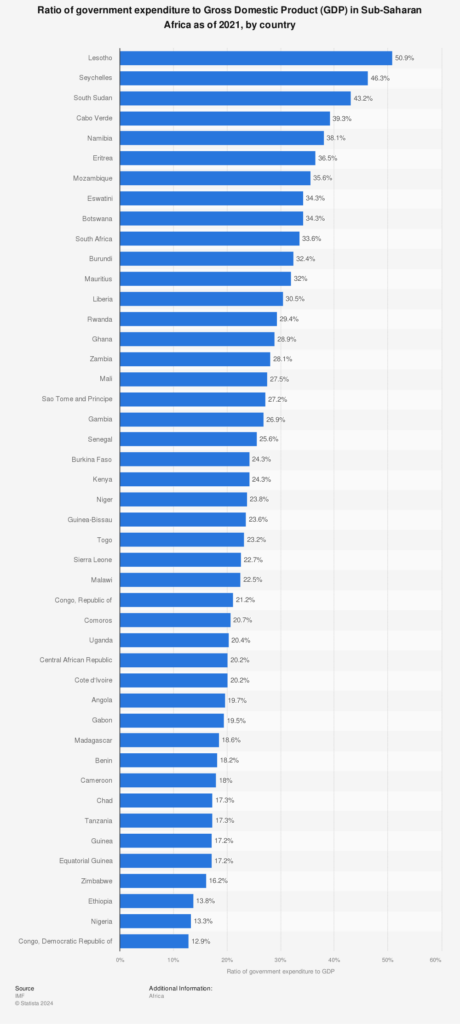Have you ever thought about how public areas, parks, schools, streets, or other state-owned publicly available infrastructures were built? With money, you would probably say. This proves true, and one ought to ask where this money came from in the first place! A government’s primary source of income is the taxes all citizens and companies pay. Income tax, value-added tax (VAT), and corporate taxes contribute significantly to government revenues and allow the state to finance projects and investments. Appendix 1 shows the tax structure by country in 2021 (OECD, 2023)
Public services are referred to as all services provided by the state for the citizens. They are funded in several ways starting by the taxes paid by the citizens and legal entities operating in the country. Yet, most of the time it is not enough, and countries have to borrow money from external parties which results in the creation of sovereign debt (IMF eLibrary, 2000).
This short article sought to understand why a country may need to create debt and how it should do so. Several mechanisms such as domestic and international borrowings will be analyzed. Then, the article wants to provide a clear understanding of the benefits, drawbacks, and hindering factors existing for a country to fund itself with debt.
Furthermore, it will be important to assess the structure of debts and the differences between these structures. Finally, the article will focus on African countries and the management of their sovereign debt. Some countries will serve as case studies to illustrate the discussed matters.
Reasons why governments use debt
A country’s economic development comes with several needs. Indeed, a country will provide several services to its population. For instance, infrastructures, healthcare, education, and social programs require substantial investments beyond immediate revenues (Tax Foundation, 2022). Moreover, shortterm liquidity needs – the need to get access to cash in a short-term horizon, usually a year – to manage fiscal deficit or emergency spending and managing natural disasters, global economic shifts, or commodity price fluctuation may also be sources of money demand from countries. Although taxes
are used to finance these investments, it often appears that this is not enough. For instance, in Appendix 2, the graph shows the budget balance in relation to the Gross Domestic Product (GDP) between 2019 and 2024 with forecasts until 2029 for the Ivory Coast. The budget balance represents the difference between government revenue and expenditures. When the balance is negative, it indicates a budget deficit, meaning the government is spending more than it earns. This deficit is
shown as a percentage of the country’s GDP, which provides context on the size of the deficit relative to the economy. Essentially, it shows how much Ivory Coast would need to borrow or raise to cover the gap between its spending and revenue each year. When there’s a deficit (a negative balance), the government may need to borrow funds, either domestically or internationally, to cover this gap (Statista, 2024-b)
Then, Appendix 3 highlights the percentage of total tax and non-tax revenues compared to GDP. This graph is useful as it assesses a country’s ability to generate revenues and the possibility of providing an analysis of fiscal capacity and economic health. The total revenue compared to GDP is even more important for developing countries as higher revenues to GDP indicate less need for borrowing funds and a better ability to sustain its economy (World Bank, 2023)
The graphs explain that the low tax and non-tax revenue-to-GDP ratio contributes to the budget deficit. Since Ivory Coast collects a limited amount of revenue relative to its GDP, it lacks sufficient internal funds to cover its expenditures, leading to persistent budget deficits. This deficit requires the country to borrow or find alternative funding sources to close the gap. Ivory Coast’s case is quite exceptional on the continent. Indeed, African countries face a complex debt landscape marked by high
and rising debt levels, reliance on external borrowing, and vulnerability to economic shocks. Debt sustainability remains a major challenge, as many countries struggle to balance debt repayments with essential spending. Ongoing efforts at debt restructuring, improved fiscal management, and alternative financing sources are critical to ensuring that Africa’s debt does not become an insurmountable obstacle to development. As shown in Appendix 4 (Statista, 2023-a), African countries exhibit varying national debt levels relative to their GDP. For instance, Eritrea’s debt is approximately 164% of its GDP, indicating a significant debt burden. Cabo Verde and Mozambique follow, with debt levels at 127% and 104% of GDP, respectively. In contrast, countries like Botswana and the Democratic Republic of the Congo maintain lower debt ratios, around 22% and 13% of GDP, respectively.
Mechanism of debt creation and structuration
Debt creation mechanisms vary, but governments typically fund their needs by combining domestic and international borrowing. Domestic borrowing includes issuing treasury bills (T-Bills)(short-term government loans that mature within a year and are sold at a discount), bonds (longer-term loans, lasting several years, where the government pays regular interest to investors until maturity), or taking loans from domestic banks, providing immediate liquidity without exposure to foreign currency risk. Both are ways for the government to raise money domestically without foreign currency risk.
International borrowing, however, involves borrowing from other countries, multilateral institutions like the World Bank and IMF, or tapping into capital markets through instruments like Eurobonds, Green Bonds, or Sukuk Bonds. Taking Eurobonds as an example, they allow African nations to raise money because those bonds are issued in foreign currencies and sold to global investors. Ghana, in particular, has used Eurobonds to finance infrastructure projects and to stimulate economic growth.
Additionally, countries may secure bilateral loans from foreign governments or multilateral loans from international institutions, often at concessional rates – lower-than-market rates – with favorable terms. For immediate funding needs, some countries resort to commercial loans from private lenders such as banks or financial institutions. However, these generally have shorter terms and higher interest rates. These forms of debt are often denominated in foreign currency and expose countries to exchange rate risks if their local currencies depreciate (Nightfox Investigations, 2023). African nations, grappling with structural fiscal deficits and external economic shocks, turn to borrowing as a solution. Ghana’s debt accumulation over the last decade is a clear example of this trend.
Debt can also be structured by a country’s economic capabilities and objectives. Concessional debt, as said before, offers low interest and extended repayment terms, making it suitable for development projects. In contrast, non-concessional debt—such as Eurobonds or commercial loans—reflects market rates and often requires quicker repayment, adding a heavier burden. Debt can be categorized as short-term or long-term: short-term debt helps meet immediate financial obligations but requires quick rollovers. Long-term debt is better suited for infrastructure investment due to its extended payment schedules. Lastly, fixed-rate debt offers stable, predictable payments, which simplifies budgeting but can be more expensive initially. Variable-rate debt starts at lower costs but is sensitive to interest rate fluctuations, potentially increasing costs over time (World Economic Forum, 2022).
Benefits
Injecting borrowed money into the economy may stimulate demand and support businesses ultimately increasing tax revenues for the states. As said, countries will borrow money for economic development. These investments not only create jobs but also enhance productivity, fostering longterm economic growth. Well-managed debt can help in attracting foreign investment. When a country responsibly handles its debt obligations, it builds a reputation for financial stability and reliability,
which increases its attractiveness to international investors and opens up new channels for future funding. Debt also plays a stabilizing role during economic downturns or crises. In challenging times, such as during a global recession (a period of significant economic decline worldwide) or a natural disaster, debt can provide the liquidity needed to maintain essential services and stabilize the economy (Oxford Academic, 2021).
For instance, Ethiopia has borrowed money to develop its energy sector, notably by constructing the Grand Ethiopian Renaissance Dam to boost electricity generation. Likewise, Kenya has financed the Standard Gauge Railway through loans, aiming to improve transportation and stimulate economic growth. These investments are part of broader strategies to address infrastructure deficits and promote development. By doing so, they strengthen their economies’ resilience and lay the foundation for recovery and growth. This strategic use of debt supports immediate economic needs while fostering a path to sustainable development if managed within a prudent debt framework (Africa International Trade, 2023).
Drawbacks
Several non-desirable situations can arise for a state when borrowing. For example, debt traps may oblige a country to continuously borrow money to repay existing debt (creating debt, need for debt creation to pay existent debts, entering debt trap). Moreover, debt servicing costs – expenses a country incurs to pay back its debt – could be too high, meaning the borrower does not have the funds to reimburse the interests and the principals of lenders’ contracts. Also, currency risk is an area of concern, especially for countries whose currency is relatively unstable and weak. For instance, a country borrowing money in a foreign currency will be subject to fluctuation in exchange rates, which is not always in favor of the borrower. When a country has a high account of foreign currency debt, it must export a lot to increase revenues. African countries are highly dependent on commodity price fluctuations meaning in times of economic downturns, their revenues, and thus their foreign currency treasury weakens which makes it even more difficult to reimburse debt (EconPapers, 2012). Lastly, it
is interesting to mention what all these drawbacks imply for the country. If a state seems to be in a budget deficit it will borrow money, which could induce debt cost servicing, currency risk, and debt traps. The more a country falls into this spiral, the lower its credit rating will be. If the credit rating is low, the cost of debt will be higher. It works like any other loan that an individual or a company contracts. Let us take the example of the Ghanaian State again. The African country entered a debt restructuring process to manage high debt servicing costs, counter currency risks, address fiscal deficits, and restore investor confidence. The restructuring process, often assisted by financial advisers like Lazard, allowed Ghana to renegotiate terms with creditors, providing immediate fiscal relief while creating a more sustainable debt repayment plan. However, this case will be the subject of a future reading.
Appendices
Appendix 1: Tax structure by country, 2021 (OECD, 2023)

Appendix 2: Ivory Coast: Budget balance between 2019 to 2029 in relation to GDP (Statista, 2024-b)

Appendix 3: Total tax and non-tax revenues as a percentage of GDP, 2021 (World Bank, 2023)

Appendix 4: General Government gross debt in relation to Gross Domestic Product (GDP) in Sub- Saharan Africa as of 2022, by country (Statista, 2023-a)

References
Africa International Trade. (2023). Debt burden and the sustainability of African real economic sectors. Retrieved from https://africainternationaltrade.com/2023/05/01/debt-burden-and-the- sustainability-of-african-real-economic-sectors/
Daberistic. (2022). Understanding taxes and government revenue. Retrieved from https://www.daberistic.com/2022tax.html
EconPapers. (2012). European Journal of Development Research: The effects of government consumption on growth. Retrieved
from https://econpapers.repec.org/article/paleurjdr/v_3a24_3ay_3a2012_3ai_3a4_3ap_3a606-626.htm
International Monetary Fund. (2018). Alesina on fiscal policy and growth. Retrieved from https://www.imf.org/en/Publications/fandd/issues/2018/03/alesina
IMF eLibrary. (2000). Government consumption and growth. Retrieved
from https://www.elibrary.imf.org/configurable/content/book$002f9781557757913$002fch003.xml?t: ac=book%24002f9781557757913%24002fch003.xml
Nightfox Investigations. (2023). Understanding government borrowing: Why, how, and what it means. Retrieved from https://www.nightfoxinvestigations.co.uk/understanding-government- borrowing-why-how-and-what-it-means/
OECD. (2023). Revenue statistics in Africa 2023. Retrieved
from https://www.oecd.org/content/dam/oecd/en/topics/policy-sub-issues/global-tax- revenues/brochure-revenue-statistics-africa.pdf
Oxford Academic. (2021). Government consumption and economic growth in Sub-Saharan Africa. Journal of African Economies, 30(Supplement_1), i14–i38. Retrieved
from https://academic.oup.com/jae/article/30/Supplement_1/i14/6395212
Prime Business Africa. (2024). 10 countries in Africa with highest debt-to-GDP ratio. Retrieved from https://www.primebusiness.africa/10-countries-in-africa-with-highest-debt-to-gdp-ratio/
Statista. (2023). National debt in relation to GDP in Sub-Saharan Africa by country. Retrieved from https://www.statista.com/statistics/1223393/national-debt-in-relation-to-gdp-in-sub-saharan- africa-by-country/
Statista. (2024). Ivory Coast budget balance in relation to GDP. Retrieved
from https://www.statista.com/statistics/452049/ivory-coast-budget-balance-in-relation-to-gdp/
Tax Foundation. (2022). Global corporate tax rates by country. Retrieved
from https://taxfoundation.org/data/all/global/corporate-tax-rates-by-country-2022/
Trading Economics. (2023). Ivory Coast government spending. Retrieved from https://tradingeconomics.com/ivory-coast/government-spending
World Bank. (2023). Taxes and government revenue. Retrieved
from https://www.worldbank.org/en/topic/taxes-and-government-revenue
World Economic Forum. (2022, October). Government debt: Economy, bonds, loans. Retrieved from https://www.weforum.org/stories/2022/10/government-debt-economy-bonds-loans/
